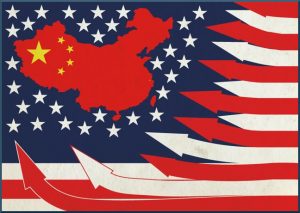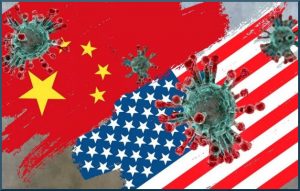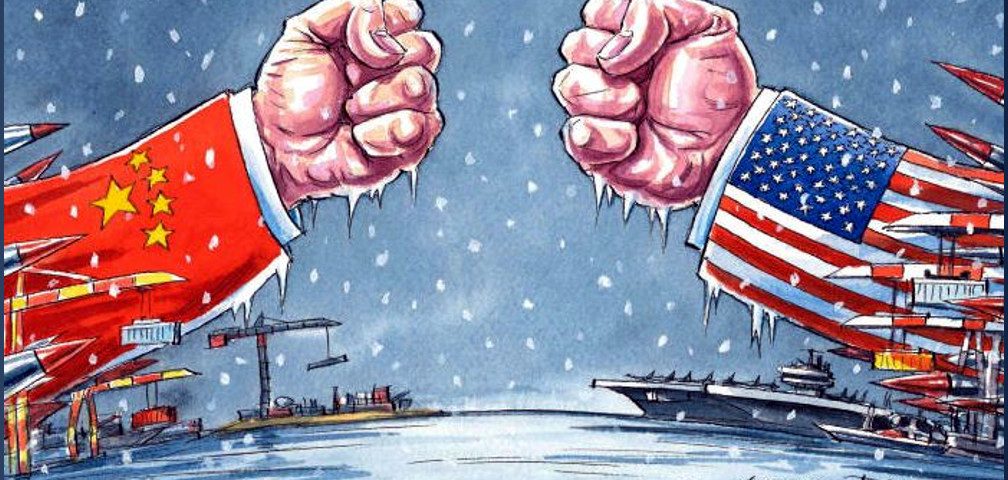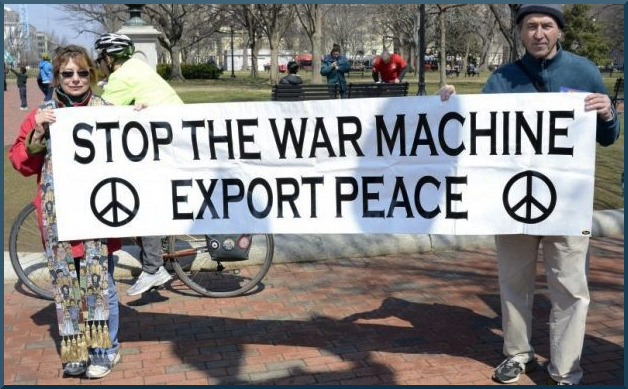by Margaret Flowers & Kevin Zeese, published on Popular Resistance, May 10, 2020
The Trump administration, in seeking to divert attention from its bungled response to the COVID-19 pandemic and mishandling of the economic collapse, is escalating the bipartisan anti-China policy, which has a long history. This increases the potential of military conflict and economic war between our countries.
President Trump is making both a global depression and war more likely. The United States needs to de-escalate its conflicts and work with China and other countries to confront the pandemic and economic collapse, as well as the climate crisis and nuclear proliferation. This is not the time for escalation of conflicts, but for de-escalation and a new era of a multipolar and cooperative world.
Bipartisan Escalation Against China Is Longterm US Policy
While some blame Trump for the escalation of conflict with China, in this century, it began with President Obama’s pivot to Asia. It now includes a full spectrum dominance strategy of military, information, and economic aggression.
 The roots of treating the Asian Pacific as a ‘US lake,’ just as Latin America is ‘our backyard,’ go back to 1878 when Navy Commodore Robert W. Shufeldt of the USS Ticonderoga described the Pacific as “the ocean bride of America.” Declaring a Monroe Doctrine for the Pacific, he described Asia as where the “search for Empire ceases and human power attains its climax.” Interestingly, it was the Panic of 1873 that led to a depression that resulted in a search for new markets. The US failed its invasion of Korea in 1871 and Shufeldt needed to improve US relations. In 1882, his mission resulted in the first treaty in the Pacific Rim signed by the US and South Korea.
The roots of treating the Asian Pacific as a ‘US lake,’ just as Latin America is ‘our backyard,’ go back to 1878 when Navy Commodore Robert W. Shufeldt of the USS Ticonderoga described the Pacific as “the ocean bride of America.” Declaring a Monroe Doctrine for the Pacific, he described Asia as where the “search for Empire ceases and human power attains its climax.” Interestingly, it was the Panic of 1873 that led to a depression that resulted in a search for new markets. The US failed its invasion of Korea in 1871 and Shufeldt needed to improve US relations. In 1882, his mission resulted in the first treaty in the Pacific Rim signed by the US and South Korea.
Today’s economic collapse is a major reason for Trump’s escalation with China but Trump is building on the policies of Barack Obama who declared himself the “first Pacific president” as part of a geopolitical strategy to challenge China. His Secretary of State Hillary Clinton wrote “America’s Pacific Century” that claimed the future will be decided in Asia and the US will be right at the center of the action. They put in place the Asian Pivot, an escalation of military confrontation with China with 60 percent of US war capacity shifting to the Pacific.
The US was already at war with China before Donald Trump entered the Oval Office. The US military and other branches of government were gearing up for a long-term conflict, involving both economic and diplomatic pressure on China with a buildup of military forces along the country’s periphery. Last Thursday, on Flashpoints on KPFA, KJ Noh pointed out that the Pivot came with the Air-Sea Battle War Doctrine designed to ensure the US maintained freedom of action throughout the globe. The US built a networked land, sea, air, space, and cyber collective warfighting capability with allied countries.
In 2011, the Council of Foreign Relations began urging the US to withdraw from the Intermediate-Range Nuclear Forces (INF )Treaty. The RAND Corporation, which advises the US military, published “Thinking through the unthinkable” in 2016. It described how the US could win a war with China, which it argued the US needs to do before 2025. The strategy is to focus on the South China Sea in a long and costly way that cuts off Chinese fuel supplies and trade. Almost a decade ago, military strategists James Holmes and Toshi Yoshihara found the First Island Chain was a natural barrier that could bottle-up the Chinese Navy.
RAND urged the US to void the INF Treaty so missiles could be directed at China. In 2018, Trump declared–as if on his own volition–the US would drop out of the INF Treaty. The US falsely claimed Russian had violated the treaty, but it was really about targeting China. In August 2019, the US withdrew from the treaty and started developing new missiles. The US then conducted the first test launch of a new ground-launched cruise missile.
The US has also been expanding military bases and military agreements in the Pacific. In September 2019, Secretary of Defense Mark Esper called for further expanding military base locations in the Pacific region while speaking at the Naval War College, calling the Indo-Pacific “our priority theatre.” Esper believes “The United States network of alliances and partnerships provides us an asymmetric strategic edge that our adversaries cannot match.”
The hybrid war against China includes an information war as well as economic conflict. Just before the novel coronavirus pandemic, the propaganda war was most evident around the Hong Kong protests and the disinformation campaign about the Uyghurs. The US has been funding anti-China activities in Hong Kong since 1996. People have mistakenly called the anti-China protests ‘democracy protests’. While there was confusion about the protests, it is obvious when they called for “Trump to Save Us” and worked with right-wing anti-China senators that Hong Kong is part of Washington’s anti-China strategy. The US passed the Hong Kong Human Rights and Democracy Act, which the US will use to justify intruding into the internal affairs of China and Hong Kong.
Similarly, reports based on dubious studies claimed mass imprisonment of millions of Muslim Uyghurs, or even that there is a Muslim Holocaust in China. These were vast exaggerations used to stoke anti-China views. The US has long backed the World Uyghur Congress as part of its effort to undermine China from within. A small minority of poor, radicalized Uyghurs, who have been involved in terrorism and violence in China and have also fought with ISIS in Syria, are a problem for China. People who visited the region and reported on the Uyghurs describe what we are hearing as ‘shameful lies’ peddled by the US empire.
Under Obama, economic domination involved the largest corporate trade agreement in history, the Trans-Pacific Partnership. The TPP included the United States and 11 Pacific Rim countries, excluding the largest economy in the hemisphere, China. It was designed to ensure US hegemony in the Asia Pacific through corporate dollar domination. Popular Resistance helped organize a five-year ‘movement of movements’ campaign that stopped the TPP. This defeat was seen as the beginning of the end of US hegemony in Asia.
But, the defeat of the TPP did not stop the US’ focus on Asia. In 2018, the United States announced a new national defense strategy, “Great Power Conflict,” with China as the top target. Around the same time, the Nuclear Posture Review announced the escalation of nuclear weapons development, which also started under Obama. The new arms race also includes space, traditional weapons, cyber defense, and surveillance.
The US fears the 21st Century will be the Chinese Century and is doing all it can to prevent that development. This has resulted in a bipartisan policy of militarily surrounding China with nuclear and other weapons.
The Trump COVID Escalation
 The Trump administration is now using the novel coronavirus to escalate opposition to China. This includes a propaganda offensive that is becoming a Chinese version of Russiagate. The Trump administration made a point to call it the “Chinese” or “Wuhan virus” until it was told this was an inaccurate description as we still do not know where it began. The propaganda continues with claims that China was not transparent, is hiding the number of deaths, punished doctors who discussed the issue, and leaked or manipulated the virus.
The Trump administration is now using the novel coronavirus to escalate opposition to China. This includes a propaganda offensive that is becoming a Chinese version of Russiagate. The Trump administration made a point to call it the “Chinese” or “Wuhan virus” until it was told this was an inaccurate description as we still do not know where it began. The propaganda continues with claims that China was not transparent, is hiding the number of deaths, punished doctors who discussed the issue, and leaked or manipulated the virus.
A thorough reality check of these claims has shown them to be false but they have built hatred for China, resulting in prejudice against Asian people and laying the groundwork for escalation. Now Trump and Biden are accusing each other of being soft on China. Biden accuses Trump of not holding China accountable while Trump is seeking to use China as a scapegoat for his failed response to the virus. Fearmongering is being used to justify escalating the economic and military conflict with China.
The reality is China had a rapid, breathtaking, and impressive response to the virus that bought countries time to respond and won praise from health experts. China allowed public health officials to examine its response, independently confirming its successful response. China’s approach provides other nations with lessons they can learn to combat the virus. In addition, China is providing assistance to nations throughout the globe to help them respond to the pandemic. Indeed, while countries received little or no help from the European Union and the United States, China along with Cuba provided aid to them.
Last month, China’s top intelligence ministry, the Ministry of State Security, presented a report by China’s Institutes of Contemporary International Relations to top Beijing leaders that warned China needs to be prepared in a worst-case scenario for an armed confrontation with the United States. This risk comes from the backlash against China over the pandemic.
This week, Reuters reported the US is investing heavily in weapons for use against China. Budget documents show the Marines sought $125 million to buy 48 Tomahawk missiles next year and $3.2 billion for hypersonic technology, mostly for research on new, long-range missiles. The Pentagon also seeks $224 million for another 53 new Long Range Anti-Ship Missiles in 2021. They expect to have more than 400 of them in service by 2025. These will be used on Navy Super Hornet jets and Air Force B-1 bombers.
Testimony also reported the Marines had successfully tested new shorter-range anti-ship weapons, the Naval Strike Missile. Reuters reports “in a radical shift in tactics, the Marines will join forces with the US Navy in attacking an enemy’s warships. Small and mobile units of US Marines armed with anti-ship missiles will become ship killers.” These would be dispersed at key points in the Western Pacific and along the First Island Chain.
China has urged the US to stop “moving around the chess pieces” in the Asia Pacific. A Chinese military spokesman, Senior Colonel Wu Qian, warned last October that Beijing would “not stand by” if Washington deployed land-based, long-range missiles in the Asia-Pacific. The US moves are leading to an arms race in the Asia Pacific. Reuters has published a series on China’s military that revealed in most categories, China’s missiles now rival or outperform US counterparts.
In addition to these plans, the US has already increased military activity in the Asia Pacific. The South China Morning Post reported on May 10, that the US increased military operations in waters close to China. This has included 39 flights over the South China Sea, East China Sea, Yellow Sea, and the Taiwan Strait, more than three times the number carried out in 2019. The US Navy also conducted four so-called freedom of navigation operations in the South China Sea in the first four months of 2020 – compared with just eight for all of 2019.
A conflict between the United States and China presents a risk of global warfare as the US has directed NATO to focus on China and has been building military relations in the Asia Pacific, especially with its closest military ally, Japan. China has also built relationships with numerous countries including Russia. The United States has been increasing military spending in the region while Russia and China have responded with the development of new weapons and also increased spending. The Pentagon is planning for a new long war with China and Russia.
Time for a Pivot to Peace
Rather than a national security strategy of major power conflict, the US needs a strategy of major power cooperation. The United Nations has called for international cooperation and a global ceasefire, which the US blocked this week.
People need to promote and work toward peace as a top priority as the risk of conflict escalates. We urge you to sign onto Peace Pivot where you can find more information on the conflict between China and the US and what you can do about it. US elected officials should not be rewarded for China-bashing. We must work together to call out the falsehoods about China so that doing so backfires against the politicians who make them.
China’s rise from poverty to becoming an engine for the global economy should not be seen as a threat to the United States. China’s Belt and Road Initiative can help all nations. If the United States responds with an escalation of economic and military conflict it will undermine US leadership and bring greater insecurity to the world. The US must work with China, and other nations in this new multipolar world to stop the pandemic, economic collapse, climate catastrophe, and the risk of nuclear war.
*Featured Image: US and Chinese Fists and Weapons face-off, from the Financial Times
Kevin Zeese & Dr. Margaret Flowers
Dr. Margaret Flowers and Kevin Zeese are co-directors of Popular Resistance. They have organized local and national campaigns for racial justice and against endless wars; in support of Chelsea Manning and in support of Single Payer Healthcare; to oppose the TTP/TTIP and more. Kevin and Margaret also have a weekly radio show and podcast called Clearing the Fog.
Kevin Zeese is an American political activist who has been a leader in the drug policy reform and peace movements and in efforts to ensure a voter verified paper audit trail. Margaret Flowers, M.D., is a Maryland pediatrician seeking the Green Party nomination for the US Senate. She is co-director of PopularResistance.org and a board adviser to Physicians for a National Health Program and is on the Leadership Council of the Maryland Health Care Is a Human Right campaign.

